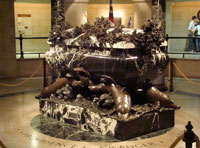
John Paul Jones' Tomb
On April 24, 1906, John Paul Jones was buried for the second time. His first burial, on July 20, 1792, in a graveyard outside the walls of Paris, was attended by a servant and few loyal friends and soldiers. Paul Jones’ longtime friend Gouverneur Morris, American Minister to France, skipped the funeral due to a pressing dinner engagement.
Theodore Roosevelt, who became president in 1901, was a great supporter of the United States Navy. He had previously served as Assistant Secretary of the Navy, and, as president, wanted to build a fleet of modern battleships, but faced significant resistance from Congress.
What Roosevelt needed was a bona fide naval hero around which to stir interest in naval shipbuilding and officer training. John Paul Jones fit the bill, especially the John Paul Jones as described in Augustus C. Buell’s popular two-volume biography, Paul Jones: Founder of the American Navy, published in 1900. (Much of Buell’s biography turned out to be fiction and forgeries. Despite this, some of the more stirring passages penned by Buell are still quoted as being written by Paul Jones.)
The problem was, that in 1901, no one remembered where Paul Jones was buried. In 1796, the French revolutionary government sold the cemetery and the surrounding property. Over the next hundred years, a grocery store, a laundry, an apartment house, sheds, cess pools and wells were built what had once been the cemetery.
Roosevelt got Congress to appropriate $35,000 (over a $1,000,000 in current terms) to locate the body. After several years of searching, Paul Jones’ coffin was located on April 8, 1905. An autopsy confirmed that the body was that of lost naval commander. The body was carried back to the United States, where it sat for almost a year until a proper tomb could be constructed for the fallen hero. Finally on April 24, 1906, John Paul Jones was laid to rest with full military honors in an elaborate tomb, modeled after Napoleon’s, before a large crowd at the United States Naval Academy in Annapolis Maryland.
The naval commander, who had been largely forgotten by his contemporaries, had returned to his adopted homeland in grand style and Teddy Roosevelt got his fleet of battleships.
